Types Of Honey
Since the profile of bees has increased significantly in
recent years, so has interest in beekeeping, but also
honey.
I thought it was time I wrote a few lines about some of the types of honey available, and a few terms around the subject.
I believe there is more interest in honey now than when I
started raising awareness of the plight of bees in 2008/9, and I can’t help
feeling that interest has also grown in speciality honeys – whether premium
organic, natural and comb honey, or honey offered for its medicinal properties.
What type of honey are you buying?
There are many differences, some subtle, others less so, in terms of characteristics, such as color, viscosity, flavor and aroma.
These difference can affect products made with honey, such as mead.
Preference is of course, personal.
Multi-floral honeys
Most honey sold is blossom honey, and is made by honey bees either
from nectar gathered from a variety of flowers (for example, from gardens, parks and the countryside). The term for this is ‘multi-floral’ or ‘poly-floral’
(‘poly’ meaning ‘many’).
Descriptions on labels are very varied, and could include, for example, wildflower honey, blossom honey, meadow honey, summer honey, among others. Tualang honey is also included in this group, and is perhaps the most premium priced multi-floral honey.
Mono-floral honeys
You can also buy honey which has been made by honey bees
foraging predominantly on a single flower type – i.e. ‘mono-floral honeys’.
These types of honey take on a distinct flavour associated with that flower, and tend to command a premium price.
Examples of mono-floral honeys include:
- heather honey,
- orange blossom honey,
- acacia honey,
- tupelo honey
- lavender honey,
- clover honey,
- manuka honey, among others.
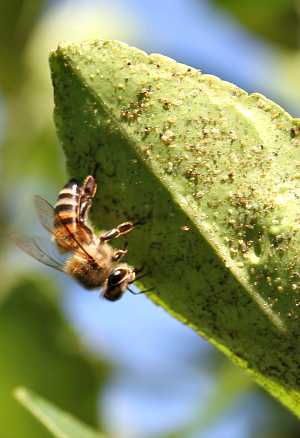 Honey bee feeding on aphid honey dew. Photograph supplied by Valerie Nicolson.
Honey bee feeding on aphid honey dew. Photograph supplied by Valerie Nicolson.
You may also have heard of 'honeydew honey' - or 'aphid honeydew honey'.
Honeydew honey is honey made with sweet, sticky secretions that bees have gathered from sap-sucking insects (Hemiptera) - indeed, you may even see bees foraging on leaves infested with aphids.
Honey presentations
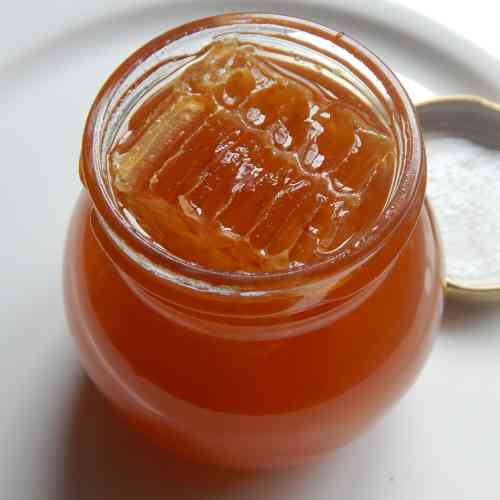 A jar of cut comb or 'chunk' honey.
A jar of cut comb or 'chunk' honey.Above is a jar of “chunk honey” or “cut comb honey” which means (as you can see) that the honey contains one or more pieces of comb honey from the hive.
The honeycomb is edible,
along with the liquid honey, and provides additional texture and interest. It's also very giftable. A premium
is usually charged for this presentation.
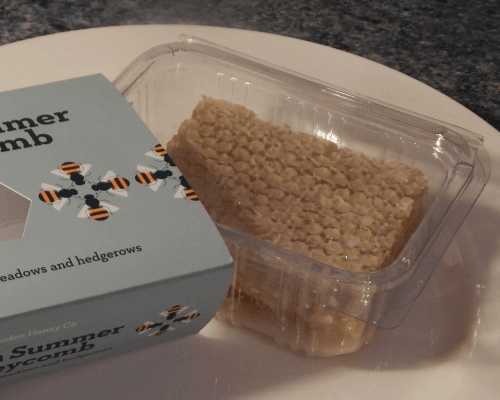 Packaged comb honey.
Packaged comb honey.
Below is a ready packaged piece of “comb honey” (again, a
premium-priced offering). This is sections
of beeswax honeycomb. Again, the whole
comb is edible.
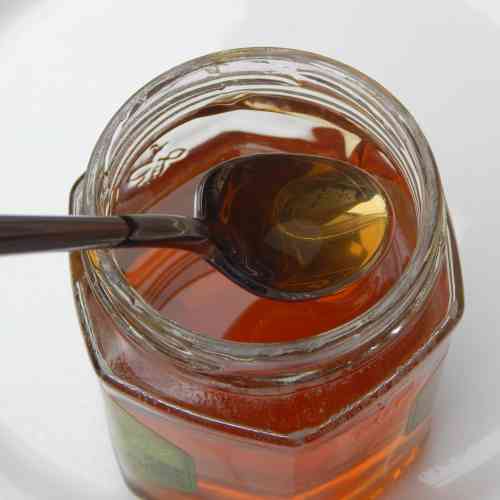 Runny honey
Runny honey
Honey varies in consistency, and some people prefer runny honey, others would rather eat soft set honey.
In order to create soft set honey, beekeepers have to control the granulation process, so that what is produced is thicker than the more liquid forms, but still smooth in texture.
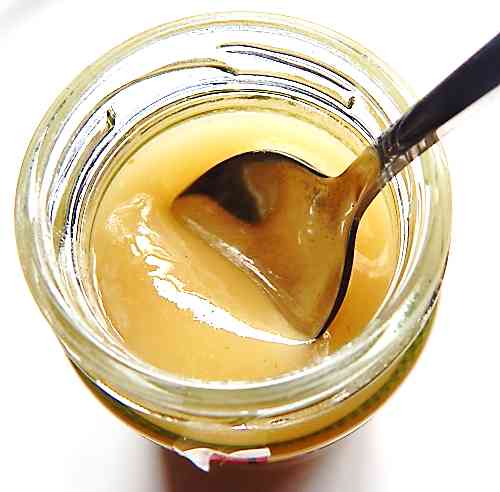 To make a soft set honey, beekeepers have to control the granulation process.
To make a soft set honey, beekeepers have to control the granulation process.
What is filtered honey?
“Filtered honey” simply means honey has been filtered to remove any body parts from dead bees, wax or other debris.
Filtering honey results in a product that for some people, looks more aesthetically pleasing and uniform in appearance, and the honey is less likely to become granulated. However, during the process, pollen is also removed.
Retaining the pollen in honey has key benefits. For example, it is possible for regulators to locate the origin of illegal honey imports. In addition, the presence of pollen can help to authenticate a premium-priced honey, such as orange blossom honey, thus protecting ethical suppliers. The study of pollen in honey is called melissopalynology.
There is also an argument that filtering reduces
some of the nutritional and taste value, and for this reason, some people
prefer raw, unfiltered honey. However, this
point is debated, since the quantity of pollen in honey is very small. The US National Honey Board comment:
“Honey is produced by honeybees from the nectar of plants, not pollen. Pollen occurs only incidentally in honey.
The amount of pollen in honey is miniscule and not enough to impact the nutrient value of honey.
A 2004 study by the Australian government found the percentage of dry weight canola pollen in 32 Australian canola honey samples ranged from 0.15% to 0.433%.
A 2012 study by the National Honey Board analyzed vitamins, minerals and antioxidant levels in raw and processed honey.
The study showed that processing significantly reduced the pollen content of the honey, but did not affect the nutrient content or antioxidant activity, leading the researchers to conclude that the micronutrient profile of honey is not associated with its pollen content and is not affected by commercial processing.
The 2012 study and abstract with statistical analysis was presented at the Federation of American Societies for Experimental Biology (FASEB) Conference in Boston April 20–24, 2013.”
What is raw
honey?
All over the internet there are various definitions and descriptions of raw honey, and I have found no confirmed international standard definition.
Again, the National Honey Board defines raw
honey as :
“..honey as it exists in the beehive or as obtained by extraction, settling or straining without adding heat.”
However, if you look on the websites of many sellers, you’ll find that at least some processing occurs, such as a minimal amount of filtration to remove debris. Depending on the supplier, the degree of processing may vary.
Honey for industrial use
You may see the term “baker’s honey”. This is basically honey that is used in the food industry as an ingredient.
If you found this page helpful or interesting, I'd really be grateful if you would share it with others - if not this page, perhaps another, such as Gardening For Bees.
Thank you so much :) .


